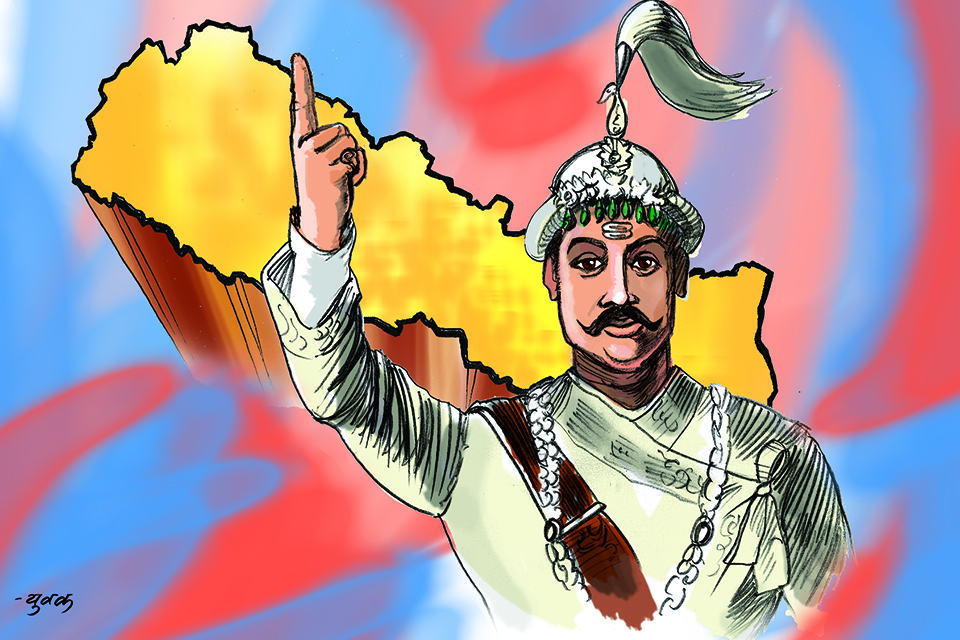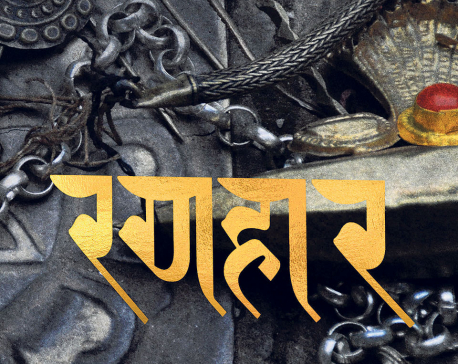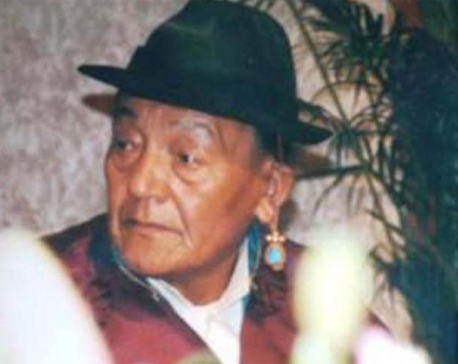
OR


Binayak Sundas
Binayak Sundas is the Assistant Professor at Centre for Himalayan Studies, University of North Bengal, Siliguribinayaksundas@gmail.com
If yardstick of nationalism is continuously held up against Prithvinarayan Shah he will always come up short, especially in the face of historical data and research.
The most common sight in Nepal used to be the statue of Prithvinarayan Shah (1723-1775), with his index finger raised to the sky while with the other hand grasping a sword, signifying strength and unity. Even after the downfall of monarchy and establishment of republic, Bada Maharaja continues to hold a special place in national imagination. The term unity, rather unification is almost synonymous with Prithvinrayan Shah, who is seen as the one who brought unity and peace to Nepal after centuries of disunity and chaos, while managing to keep the British out of the Himalayan kingdom. As such, Prithvinarayan Shah’s stature in Nepal is perhaps the same as that of Mohandas Karamchand Gandhi’s in India, George Washington’s in the United States and Mohammed Ali Jinnah’s in Pakistan.
Father figure narrative
It is interesting to note that Prithvinarayan Shah was not always seen as the father figure of Nepal and its people. That mantle at one time fell on Jung Bahadur Rana. The “cult” of Prithvinarayan Shah was one that was carefully crafted over a period of half a century. It has far more important political and, maybe even social, role to play, than what most people perceive or care to admit.
It all started in Darjeeling in the early 20th century by Surya Bikram Gyawali, as an opposition to the legitimacy of Rana regime. Then, it must be remembered, Darjeeling was a “bohemian” town, where dissenters of oppressive Rana regime found refuge, where Nepali literature flourished, while strict censorship was imposed by Ranas in Nepal. After the end of Rana rule and restoration of Shah dynasty in the 1950s, a new form of history was commissioned by the state, one where the role of Shah dynasty and Prithvinarayan Shah, in particular, was highlighted.
The cult was vigorously promoted through history texts and symbols such as statues and pictures. Nepal periodized its history where the medieval history was shown as a time of disunity under the Mallas and the modern history beginning with the unification of Nepal. Prithvinarayan was presented as the unifier of Nepal, with D R Regmi stressing on his nationalistic spirit which he argued was what drove him to unite the country in his book Modern Nepal. Regmi changed this stance in his later editions. Later historians such Ludwig F Stiller, the author of The Silent Cry and The Rise of the House of Gorkha, could not help but speak of “dreams of unification” of Prithvinarayan Shah. Though Mahesh Chandra Regmi in An Economic History of Nepal stressed on the economic aspects of the unification process he too stopped short of outrightly dismissing it. It is perhaps understandable, how it was Kumar Pradhan, a historian from Darjeeling untainted by the propaganda of the cult of Prithvinarayan Shah, openly opposed the concept of unification and Prithvi Narayan's role in his book The Gorkha Conquests.
Anthony D Smith’s argument of national historians, national history and national heroes, in The Ethnic Origins of Nations is perhaps most appropriate to explain the spread and promotion of Prithvi Narayan cult in Nepal. Smith talks about kind of history that the nation would want and ‘nationalist’ historians that it would want to write. He argues that it is not the desire to see the past as it really was but rather a yearning to breathe life into the past, recreate a fully living past and make it respond to our needs, for which such histories are written. This is exactly what happened in Nepal post-1950 when as Richard Burghart argues, the concept of Nepal as a nation began to take shape. Anthony D Smith stresses the importance of the cult of great men who express people’s attachment to their nation and are exemplars of community and its virtues. The hero is the exemplification of the golden age. He is believed to inspire fresh glories in a renewed nation. This is what Prithvinarayan Shah was meant to be, a hero meant to inspire the readers perhaps even the writers themselves. This is why his personality gets highlighted so much, with Regmi calling him a national hero and Stiller talking about his ‘unification’ dream.
Big picture
The historical Prithvinarayan was by no means unimpressive. He managed to extend the boundaries of his state well beyond what was managed by anyone in the Himalayan region since the time of the Khas Malla Empire of the 13th century. However, neither his conquest of Kathmandu valley nor his incursions into eastern hills was a blitzkrieg. It was a painstakingly long campaign spread over decades. Several atrocities were committed by his troops, such as the massacre of Limbus in the east, where at one particular incident even pregnant women were not spared as well as the mutilation of defenders in Patan. Most importantly he had absolutely no desire for any sort of unification or a creation of a nation.
In 1770, after his conquest of the valley, he sent a letter to then Mughal emperor, Shah Alam II in Delhi, calling himself the Zamindar of Gorkha and head of all Sardars in the region. He requested to be granted a title of “Yul Bakshi Shamsher Bahadur Jung” with a Mansab rank of 5000 Zat and 3000 sawar. This essentially made him a noble of the Mughal dynasty, though by now, the Mughal titles, like the Mughal Empire, were more nominal than anything else.
Seeking Mughal title and accepting Mughal suzerainty does not mark a major departure from the set process of seeking legitimacy in the region. It was claimed that Mahendra Malla (1560-1574), had been granted the right to mint coins by Akbar himself. The Kathmandu valley rulers sent tributes, in the form of elephants and other goods, to Mughal court. The Persian title of “Shah” was again claimed to have been granted by Mughal Emperor. Hence the Mughals were seen as a source of legitimacy in the region. It is in this light that Prithvinarayan Shah’s request for a Mansab rank and title has to be seen. To begin with, whoever penned the letter to the Mughal emperor, since it was written in Persian, seems to have a decent idea about the working of the Mughal dual rank system or Mansabdari system, as it was known. The sawar rank cannot rightly be higher than the zat rank, hence the 5000 zat and 3000 sawar. The second aspect is that ranks of 5000 and above were only given to the members of the royal family and high ranking nobles. Those with such high Mansab ranks were known as Amir-i- Umda. At one point important nobles such as Maharaja Man Singh of Amber, Maharaja Sawai Jai Singh, Mirza Aziz Koka Khan-i-Azam, Khan-i-Jahan Lodi etc held these ranks. Even if just nominal, it was a rank of considerable status.
Prithvi Narayan Shah’s Divya Upadesh is often seen as a primary source of understanding his idea of kingship and statehood. However, over the years, many historians have expressed doubts about the authenticity of the document. Many of the sayings attributed to Prithvinarayan Shah, goes the argument, were added much later. One of the lines of this document that is generally agreed as being historically accurate is the one that once hung over Darbar Marg in Kathmandu: Mera Saana dukhale arjyako muluk hoina sabai Jaatko phulbari ho (this kingdom acquired by no little pain by me is a garden for all castes).
This is often portrayed as definitive proof that even if nationalism cannot be attributed to Prithvinarayan, he definitely had some sense of common cause with the people and wanted a country where all castes could live together. This quote can be understood well if it is read with entire paragraph: Sipaahi Bhaibhaaraadaarle Svakh garyanan Bhannya charai Khutmaa mero tarbar bajanaichha, Svakhma paso bhanya mero saanaa dukhle aarjyaako muluk hoina sabai jaatko phulbari ho, sabailaai chetanaa bhayaa yo phulbaariko choto badaa chaarai jat chhatisai varnale, yo Asil hindusthaan ho (If (my) soldiers and courtiers are not given to seeking pleasure, my sword can strike in all directions. If they are given to pleasure, this will not remain a kingdom acquired with no little pain by me, but (it will be) common garden for all kinds (of people). But if everyone is watchful, this will be a true Hindustan…of all higher and lower castes (jati) and thirty-six varna (Translation by Kumar Pradhan).
Kumar Pradhan and John Whelpton both agree that this was a warning that his new state should not turn into a garden of all castes. Hence the line implied the exact opposite of what it was used to propagate completely ignoring the part where it says this will be ‘a true Hindustan.’
Reverting to antiquity
The attempt to give nationalistic motives to Prithvinarayan Shah is akin to the national museum in Belgrade depicting the first Serbian uprising against the Ottomans under Karageorgev in 1804-13 as an example of Serbian nationalism, thought the peasants who led the uprising against the Ottomans hardly had any concept of a Serbian nation.
Benedict Anderson refers to Barons, who forced John Plantagenet to sign the Magna Carta, being hailed as patriots in English classrooms today. The truth is that the French-speaking Barons did not even speak English and never thought of themselves as Englishmen. Finding nationalistic intentions in the actions of the Barons, Karageorgev and Prithvinarayan Shah are attempts to help the people of a nation place the origins of their nation in antiquity. In case of Nepal, building nationalism around the Shah dynasty and Prithvinarayan Shah was a part of a concentrated effort to build the legitimacy of Shahs while completely obliterating any memory of Rana regime and countering demands of democracy.
If the yardstick of nationalism is continuously held up against Prithvinarayan Shah he will always come up short, especially in the face of historical data and research. However, this does not take away the fact that he was an extraordinary ruler who through his force of determination broke away from his small keep at Gorkha and set the foundations of the Gorkha Empire.
The fact that the empire was imperialistic in nature and destroyed several cultures and languages is a different matter.
The author is a PhD research scholar at School of Social Sciences, Jawaharlal Nehru University
binayaksundas@gmail.com
You May Like This

Ranahăr: Historical fiction on the last Malla king
KATHMANDU, June 2: Nepa-laya’s next -- Ranahăr’, meaning defeat in war-- is a fictionalized account of the historical portrayal of the... Read More...

Last king of Mustang dies at 86
KATHMANDU, Dec 17: When Jigme Dorje Palbar Bista, who was revered as king in Mustang culture, turned frail a few months... Read More...

The cult of small
When asked about the ‘key’ to Iceland team’s success, players attributed it to special bonding between them ... Read More...



Just In
- World Malaria Day: Foreign returnees more susceptible to the vector-borne disease
- MoEST seeks EC’s help in identifying teachers linked to political parties
- 70 community and national forests affected by fire in Parbat till Wednesday
- NEPSE loses 3.24 points, while daily turnover inclines to Rs 2.36 billion
- Pak Embassy awards scholarships to 180 Nepali students
- President Paudel approves mobilization of army personnel for by-elections security
- Bhajang and Ilam by-elections: 69 polling stations classified as ‘highly sensitive’
- Karnali CM Kandel secures vote of confidence















Leave A Comment